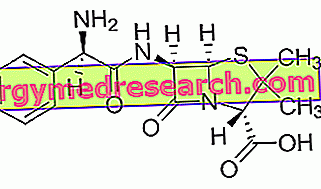Ampicillin is a broad-spectrum β-lactam antibiotic belonging to the penicillin class.
Indications
For what it uses

Ampicillin - Chemical Structure
Ampicillin is indicated for the treatment of various types of infections caused by both Gram-positive and Gram-negative bacteria.
More specifically, ampicillin is indicated for the treatment of:
- Respiratory infections (such as tonsillitis, pharyngitis, sinusitis, pneumonia, bronchopneumonia, etc.);
- Urinary tract infections (such as cystitis, urethritis, etc.);
- Intestinal infections (gastroenteritis, salmonellosis and bacillary dysentery);
- Biliary tract infections, cholecystitis and angiocolitis;
- Haemophilus influenzae infections ;
- Various infections (such as otitis, endocarditis, gonorrhea, surgical infections).
Furthermore, ampicillin can be used in pre- and post-operative antibiotic treatment.
Warnings
Before taking ampicillin it is necessary to have excluded any allergies towards other penicillins or cephalosporins (another class of antibiotic drugs).
When ampicillin is administered for long periods and at high doses, periodic checks of blood counts and liver and kidney function are recommended.
Ampicillin could promote the onset of a Clostridium difficile infection in patients being treated with the drug. The risk of contracting this infection is greater in patients over 65 and in women near the birth.
Ampicillin could cause side effects that could affect the ability to drive or use machines, so care should be taken.
Interactions
Concomitant administration of ampicillin and aminoglycosides (another class of antibiotic drugs) may result in mutual enhancement of the therapeutic effects.
Concomitant use of ampicillin and probenecid (a drug used in the treatment of hyperuricemia and gout) causes an increase in the plasma concentration of ampicillin itself and a decrease in its elimination rate.
Concomitant administration of ampicillin and allopurinol (a drug used in the treatment of gout) may promote the appearance of allergic skin reactions.
Ampicillin may increase the plasma concentration of digoxin (a drug used to increase the strength of cardiac contraction), therefore, the dose of digoxin administered may need to be adjusted.
Ampicillin may interfere with the action of methotrexate (an anticancer medicine).
Ampicillin can interfere with the action of oral contraceptives, decreasing their therapeutic efficacy.
Side effects
Ampicillin can cause various types of side effects, although not all patients experience them. This is due to the different sensitivity that each individual has towards the drug. Therefore, it is said that the adverse effects do not all occur with the same intensity in each patient.
Below are the main side effects that can occur during therapy with ampicillin.
Allergic reactions
Ampicillin - as, indeed, all penicillins - can trigger allergic reactions in sensitive individuals. Such reactions generally manifest themselves in the form of skin rashes, such as - for example - multiform rashes or maculopapulosis, itching and hives.
More rarely - especially after parenteral administration - severe anaphylactic reactions may occur.
Gastrointestinal disorders
Treatment with ampicillin may cause nausea, vomiting, diarrhea, glossitis and stomatitis. These side effects occur especially when ampicillin is administered orally.
In addition, the drug can cause inflammation of the large intestine.
Blood and lymphatic system disorders
Treatment with ampicillin can cause disorders in the system responsible for the production of blood cells (the hemolymphopoietic system, in fact). Such disturbances can cause:
- Anemia, ie the decrease in the amount of hemoglobin in the blood;
- Piastrinopenia, ie the decrease in the number of platelets in the bloodstream;
- Eosinophilia, that is an excessive increase of eosinophils in the blood;
- Leukopenia, ie the reduction in the number of leukocytes in the bloodstream;
- Agranulocytosis, ie the excessive reduction of granulocytes in the bloodstream;
- Purple.
This type of side effects are not very frequent and it is believed that they too are the expression of a possible hypersensitivity to ampicillin.
Generally, these side effects are reversible with treatment interruption.
Nervous system disorders
Ampicillin therapy may cause:
- dizziness;
- Headache;
- Myoclonus (ie the involuntary and sudden contraction of a muscle or a group of muscles);
- Convulsions.
Renal disorders
Treatment with ampicillin may cause acute interstitial nephritis, crystalluria and acute renal failure.
Other side effects
Other side effects that may occur during ampicillin therapy are:
- Fever and swollen lymph nodes;
- Drug fever;
- Angioneurotic and / or laryngeal edema;
- Allergic vasculitis;
- Toxic epidermal necrolysis;
- Increased blood concentration of transaminases;
- Prolongation of bleeding and coagulation time.
Overdose
Overdoses of ampicillin are quite rare. However, if you suspect you have taken an overdose of medication, you must inform your doctor immediately or contact the nearest hospital.
Symptoms that may appear as a result of overdose are nausea, vomiting, diarrhea or convulsions.
Action mechanism
Ampicillin is a penicillin and - as such - is able to alter the synthesis of the bacterial cell wall, the peptidoglycan.
Peptidoglycan is a polymer consisting of two parallel chains of nitrogenous carbohydrates, joined together by transverse bonds that are formed thanks to a particular enzyme, transammidase.
Ampicillin binds to transammidase, preventing the formation of transverse bonds, thus creating weak zones within the peptidoglycanic structure that lead to lysis and death of the bacterial cell itself.
Mode of Use - Posology
Ampicillin is available for oral administration in the form of hard capsules, tablets, oral drops and oral suspension powder. In addition, ampicillin is also available for intramuscular or intravenous administration as a powder and solvent for solution for injection.
Below are the dosages of ampicillin normally used. However - in severe cases - the doctor may decide to increase the doses.
Oral administration
For adults, the dose of ampicillin administered is 2-3 g of drug per day, to be divided into two or three administrations.
For children between 5 and 11 years of age, the recommended drug dose is 5-10 ml of oral suspension every six hours.
For children from 0 to 5 years of age, the dose of ampicillin usually used is 100 mg / kg of body weight per day, to be divided into four administrations.
Slow intramuscular or intravenous administration
In this case, the dose of ampicillin usually used in adults is 1 g of drug every eight hours, or 2 g every twelve hours.
In children between 5 and 11 years of age, the usual dose of medication is 500 mg every eight hours.
In children from 0 to 5 years of age, the recommended ampicillin dose is 100 mg / kg of body weight per day, to be administered in three divided doses.
Pregnancy and breastfeeding
The use of ampicillin by pregnant women and mothers who are breast-feeding should be done only under the strict supervision of the doctor and only in cases of real need.
Ampicillin is minimally excreted in breast milk, but the doses of drug that pass into milk are very low and should not cause adverse effects in the newborn. However, in newborns whose mothers take ampicillin during lactation, allergic sensitization to ampicillin itself may occur, so caution should be used.
Contraindications
The use of ampicillin is contraindicated in the following cases:
- Known hypersensitivity to ampicillin, to other penicillins or to cephalosporins;
- Infections caused by bacteria capable of producing β-lactamases (particular enzymes that degrade β-lactam antibiotics - including ampicillin - preventing it from performing its therapeutic action);
- In patients who have suffered from jaundice or severe hepatic failure caused by the ampicillin itself.



